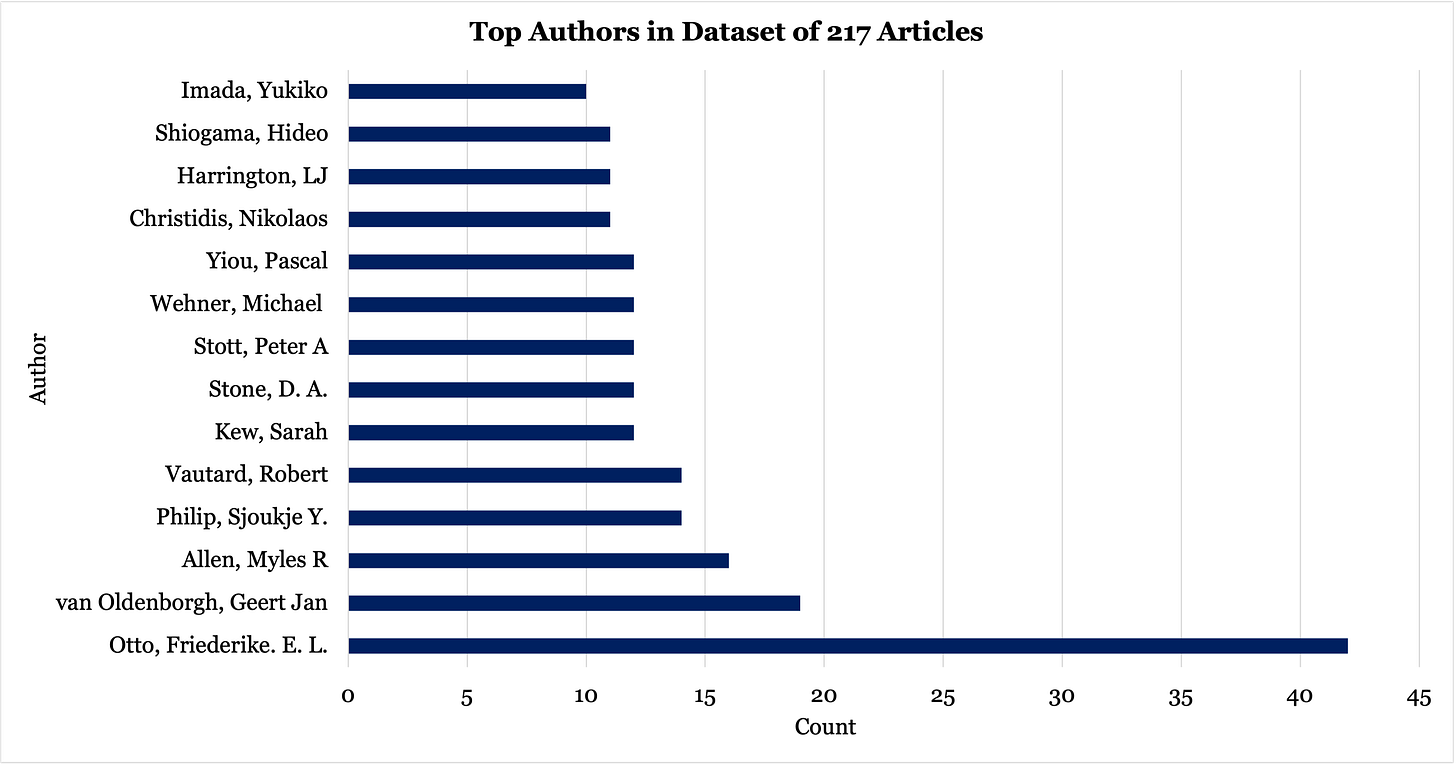The ‘loudness’ of messaging around the concept of ‘extreme event attribution’ gives the impression of an associated broad science. This is not necessarily the case.
This post is a back of the envelope sketch of the scope of the event attribution literature with a focus on where it is coming from. The media, coupled with the political and legal invoking of EEA methods, creates the effect of funhouse mirrors making the literature seem bigger or more robust than when viewed without distortion.
Queries into Web of Science (WOS), a common search engine of scientific literature, using the terms below and limited to original research “articles” produces 217 articles.1
Here is my list of articles.
"Attribution of climate extreme event*" OR "attribution of weather extreme*" OR "event attribution" OR "extreme weather attribution"
AND
"climate change" OR "global warming"How is my list of resources different from those databases of resources found at other popular internet sites? My search has a focus on peer reviewed scientific journal articles explicitly focused on the defined phrases found in the title, abstract or keywords (see grey box). This means that articles not using these phrases are not in my list of articles. See more at2.
Web of Science offers useful analytical tools for quickly understanding where a body of work is coming from.
The chart below shows the top authors represented in my list of articles. Each person is an co/author on 10 or more articles in my list.
These authors account for nearly 45% of the articles in my list. In other words, the published literature of extreme event attribution (EEA) is highly concentrated around a handful of people.
The obvious standout is that Friederike Otto, lead of the World Weather Attribution group, is an author on nearly 20% the articles. Otto authored twice as many articles as the next highest ranking author, Geert Jan van Oldenborgh, who co-lead the WWA until he passed away several years ago.
42% of the articles in my literature search have at least one author with an affiliation at an institution that is part of the WWA core team.
The chart below shows the funding agencies named on 10 or more articles in the dataset. Standing out is the substantial European support for this work.
This basic analysis of the literature as defined in my search indicates a concentration of the EEA literature among a relatively narrow group of people and over 40% of the literature is plausibly associated with WWA and its advocacy work.
Extreme event attribution is challenged on grounds of science, logic, ethics, and politics. The extent to which it remains a disputed practice is apparent in the recent National Academy of Science workshop where for 3 hours climate modelers discussed inherent challenges in the practice and confusion about why it was being pursued. The most direct assertion on why the EEA is pursued- litigation- was given by a vice chair of the IPCC Working Group I.3
The concentration in the literature matters in the broader context of strategic funding and advocacy support of the WWA, and use of its methods in litigation and policy.
These social characteristics undermine claims that EEA work is sturdy, broad, or robust. Instead, a simple breakdown of authorship suggests a literature that is niche, disputed, and dominated by advocacy interest.
This means that literature that does not use these phrases in the title, abstract, or keywords will not show up in the search. The term “storyline” appears 15 times in the articles from my search. Not all the articles in the set share the same sentiment. I used the Web of Science Core Collection. I quick search using Scopus, a similar search engine, returned similar results.
My search produces results starting with Pall et al 2011. As such, there are missing notables such as Allen’s 2003 work that set the stage but did not use the phrase event attribution. Today, popular vernacular emphasizes some form of “event attribution” so taking a look at the literature with some derivation of the phrase is informative but not comprehensive.
The Sabin Center at Columbia University includes at least some studies that do not focus on attribution of singular events at all and mentions “attribution” in passing. For example, this paper measures hail frequency over time and uses the term “attribution” once- as part of the copyright license.
CarbonBrief’s database was put together using a “broad search on the Scopus database of scientific papers produced a large dataset of potentially relevant studies.” Then an AI tool was used to identify relevant papers from that search. Carbon Brief and Sabin Center includes additional documents disseminated through groups like World Weather Attribution, Climate Signals, the Health Attribution Library, Climate Central, NOAA News Releases, and perhaps others.
Others seemed to understand the pursuit of these methods as a means of advancing computing technology or, to a lesser extent, as a hook for funding to support in situ data collection. Curious was a moderator question to the panelists on when EEA would be ready for “prime time.”







Looks like the great majority of this garbage literature is funded by government agencies and international government agencies like the EU. Cut the funding!
Another valuable contribution to the unmasking and exposure of the falsehood which has such a grip on the current state of public awareness:
human caused, dangerously accelerated planetary warming exclusively through the use of fossil fuel since the industrial revolution. aka AGW.
The propaganda began in the late 1980's despite mainstream science having already established most of the main causes of terrestrial climate changes as changes in the amount of energy coming into the earth from the sun and the changes in that input caused by sun and solar system cycles. It was already known that the trace presence of carbon dioxide was already making its almost maximum contribution to the equilibrium mean temperature - aka greenhouse effect.